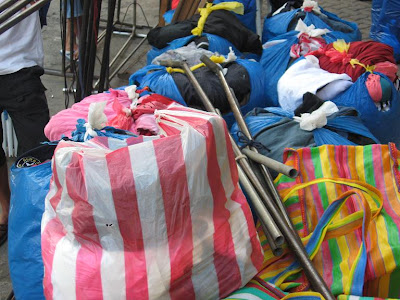 When the two-day night bazaar has ended and the weary purveyors have all packed up and gone their separate ways, those with hefty profits having driven away a-celebrating while whose who lost in their enterprises are content with nursing their hurts, what is left at the scene?
When the two-day night bazaar has ended and the weary purveyors have all packed up and gone their separate ways, those with hefty profits having driven away a-celebrating while whose who lost in their enterprises are content with nursing their hurts, what is left at the scene?These random shots in and around the plaza, scene of the excitement the previous two nights, starkly reveal an ugly underbelly of a city grown beyond its capacities to take care of many of its dispossessed citizens, many now reduced to being nocturnal denizens of the dark and seedy corners of the city and eventually uninvited tenants to the plaza.
Taken at about 7:20 am Sunday, the occupants of the plaza are shown in various sleeping positions allocating for themselves whatever little comfortable niches they can find, dead and unmindful to the flexing flurry of activities typical to an awakening city.
One elderly gentleman though asleep looks decently dressed and ready to travel, with his neat bundle of luggage serving as props to his arched body cozily adapted to the size and contours of a smallish plaza bench. A spot to sleep for!
Others in literally hard places – cold, dirty, and rough sidewalks, or concrete plaza benches not even comfortable enough for sitting in. Others go for the more spacious concrete benches near or surrounding the several statues of famous men revered locally and nationally.
Surprisingly one still senses the self-same stubborn peace and serenity we always associate with sleep, especially deep sleep, viewing their arched bodies and unwashed faces. Overall, showing the unmistakable signs of how hardy life is on the streets –deeply dirty clothes, badly sunburnt skin, and unnaturally aged faces showing even among the younger ones.
In other areas, clusters of neatly dressed young adults looking well rested and refreshed occupy the unused benches, happily giggling amongst themselves. Definitely not residents of the plaza and more like students waiting for their rides or friends to some happy excursions. The area is noted as a meeting place for those who signed up for white water rafting in the city’s now famous river.
Thus, everything appears well and good. And the city moves along to another day.







And lastly, another stolen shot - shooting back at yours truly:

Related articles:
Nite Cafe Revisited
CDO Nite Cafe - Still
Scenes Around Divisoria Park - 2
Scenes Around Divisoria Park - 1








.JPG)



































